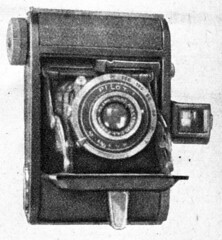Baby Pilot
The Baby Pilot (ベビーパイロット) is a Japanese 3×4 folder, made by Tachibana Shōkai from 1941 to about 1943 and advertised again in 1948.[1] It is essentially a bakelite copy of the Baby Pearl.
Contents
Description
The Baby Pilot is a vertical folding camera with a bakelite body — only the folding bed is made of metal.[2] The overall shape and incurved body struts are copied from the Baby Pearl by Konishiroku. The bakelite has a pattern imitating a leather covering, and the name Baby Pilot is moulded on the front of the body.
The camera has a folding optical finder and no body release. The bakelite advance knob is on the bottom side of the body (opposite the viewfinder). The back is hinged to the left and has two uncovered red windows to control the film advance. All the models have a front-cell focusing lens and an everset shutter.
Evolution
Prewar and wartime Baby Pilot
The camera was announced in early 1941.[3] An advertisement dated September 1941 lists two lens options (f/4.5 and f/3.5, both called Pilot Anastigmat) and three shutter options (T, B, 25–150; T, B, 5–200 and T, B, 1–300, all three called Pilot).[4] It is said that an f/6.3 lens was also available and that the camera was effectively sold from 1942 only.[5]
An advertisement dated February 1942 lists two versions only, both with a Pilot shutter giving T, B, 25, 50, 100, 150 speeds:[6]
In the advertising picture, the aperture scale is at the bottom of the shutter plate and the name PILOT is at the top. The lens is certainly front-cell focusing.
The two above versions are also mentioned in the April 1943 government inquiry on Japanese camera production, under the names "Baby Pilot I" (f/4.5) and "Baby Pilot II" (f/3.5).[7] The two lenses have three elements and were made by Sugimoto, as well as the Pilot shutter.[8]
Postwar Baby Pilot II and V
The Baby Pilot was advertised again in 1948 by Tachibana Shōkai.[9] Two versions were available:[10]
- Baby Pilot II: Pilot 50/4.5 lens, Pilot shutter, B, 25–150 speeds;
- Baby Pilot V: Pilot 50/3.5 lens, Pilot shutter, B, 25–150 speeds (the name "Baby Pilot V" might be a typo for "Baby Pilot I").
The postwar examples were probably assembled from a stock of unused parts. A picture of the Baby Pilot appears in an article on Japanese cameras in the December 1949 issue of Photo Art, but this document possibly lists discontinued models as well.[11]
Actual examples
A few surviving examples have been observed so far. They are externally identical, and it is not known if they were made before or after 1945 — examples assembled before and after that date are perhaps undistinguishable. All have an f/4.5 lens, and the lens number has only two or three digits, indicating that the camera was produced in very small quantities.[12]
The shutter speeds are 150, 100, 50, 25, B, T, engraved in that order on the rim. The shutter plate is inscribed PILOT.O at the top, and the lens marking is Pirot Anastigmat, with a typo caused by the fact that Japanese phonology does not distinguish between the "l" and "r" letters.
Notes
- ↑ Made by Tachibana: advertisements published in Asahi Camera January and September 1941, reproduced in Kokusan kamera no rekishi, p.83, say that Tachibana was the maker and distributor of the Pilot cameras: "パイロツト写真用品製造発売元". This is also confirmed by the "Kokusan shashinki no genjōchōsa" ("Inquiry into Japanese cameras"), items 168–9. Dates: Kokusan kamera no rekishi, pp.339 and 358.
- ↑ Bakelite body: "Kokusan shashinki no genjōchōsa" ("Inquiry into Japanese cameras"), items 168–9; Kokusan kamera no rekishi, p.358 (about the postwar models); McKeown, p.910.; Zaisu Ikon, p.7. This is confirmed by the available pictures.
- ↑ Kokusan kamera no rekishi, p.339.
- ↑ Advertisement in Asahi Camera, reproduced in Kokusan kamera no rekishi, p.83.
- ↑ Kokusan kamera no rekishi, p.339.
- ↑ Advertisement in {SB}}, reproduced in Kokusan kamera no rekishi, p.83.
- ↑ "Kokusan shashinki no genjōchōsa" ("Inquiry into Japanese cameras"), items 168–9.
- ↑ "Kokusan shashinki no genjōchōsa" ("Inquiry into Japanese cameras"), lens items Jb7 and Jc13, shutter item 12-V-8.
- ↑ Kokusan kamera no rekishi, p.358.
- ↑ Kokusan kamera no rekishi, p.358.
- ↑ Photo Art December 1949, p.36.
- ↑ Examples pictured in Sugiyama, item 1221, (lens no.124), in Zaisu, p.7 of Camera Collectors' News no.57, in McKeown, p.910, and observed in an online auction (lens no.91).
Bibliography
- Asahi Camera (アサヒカメラ) editorial staff. Shōwa 10–40nen kōkoku ni miru kokusan kamera no rekishi (昭和10–40年広告にみる国産カメラの歴史, Japanese camera history as seen in advertisements, 1935–1965). Tokyo: Asahi Shinbunsha, 1994. ISBN 4-02-330312-7. Item 178 and 683. (See also the advertisements for item 177.)
- "Kokusan shashinki no genjōchōsa" (国産写真機ノ現状調査, Inquiry into Japanese cameras), listing Japanese camera production as of April 1943. Reproduced in Supuringu kamera de ikou: Zen 69 kishu no shōkai to tsukaikata (スプリングカメラでいこう: 全69機種の紹介と使い方, Let's try spring cameras: Presentation and use of 69 machines). Tokyo: Shashinkogyo Syuppan-sha, 2004. ISBN 4-87956-072-3. Pp.180–7. Items 168–9.
- McKeown, James M. and Joan C. McKeown's Price Guide to Antique and Classic Cameras, 12th Edition, 2005-2006. USA, Centennial Photo Service, 2004. ISBN 0-931838-40-1 (hardcover). ISBN 0-931838-41-X (softcover). P.910.
- Photo Art December 1949. "Ōru kokusan kamera" (オール国産カメラ, All of Japanese cameras). Pp.34–41.
- Sugiyama, Kōichi (杉山浩一); Naoi, Hiroaki (直井浩明); Bullock, John R. The Collector's Guide to Japanese Cameras. 国産カメラ図鑑 (Kokusan kamera zukan). Tokyo: Asahi Sonorama, 1985. ISBN 4-257-03187-5. Item 1221.
- Zaisu Ikon (座椅子遺恨, probably a pseudonym of Y. Saji). "Besuto sanka (B-1)" (ベスト讃歌[B-1], Vest hymn [B-1]). In Camera Collectors' News no.57 (March 1982). Nishinomiya: Camera Collectors News-sha. P.7.
